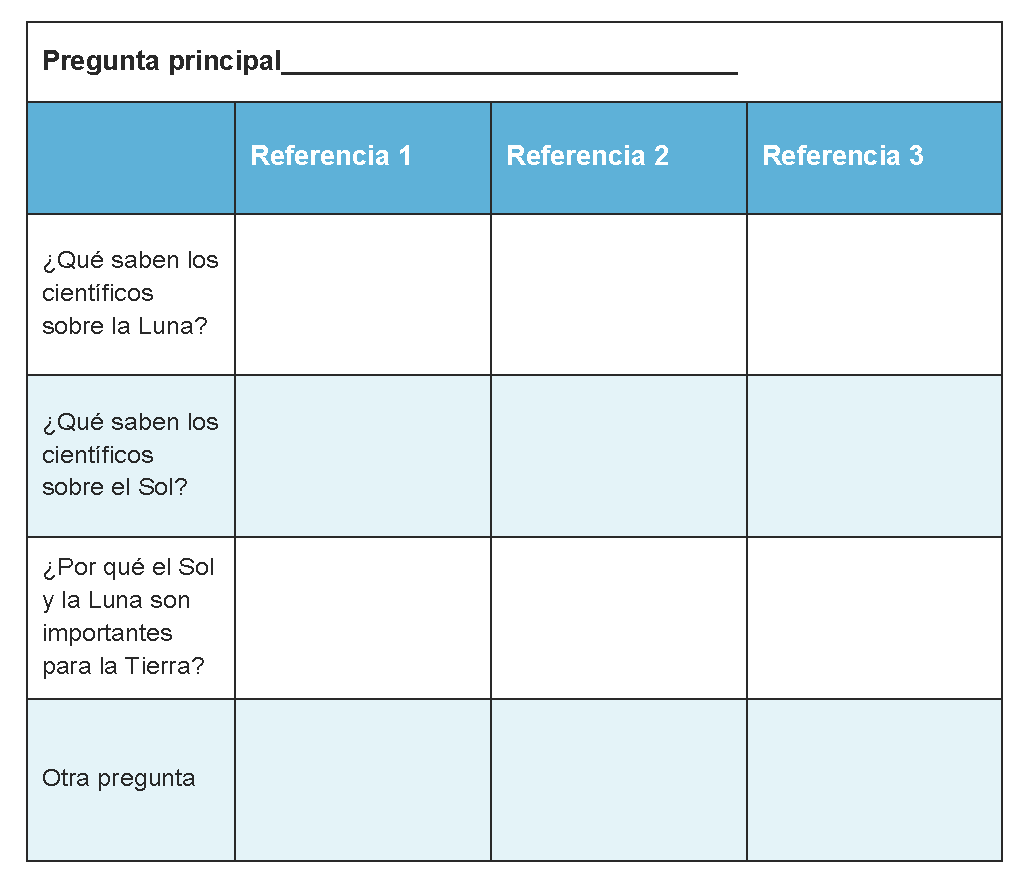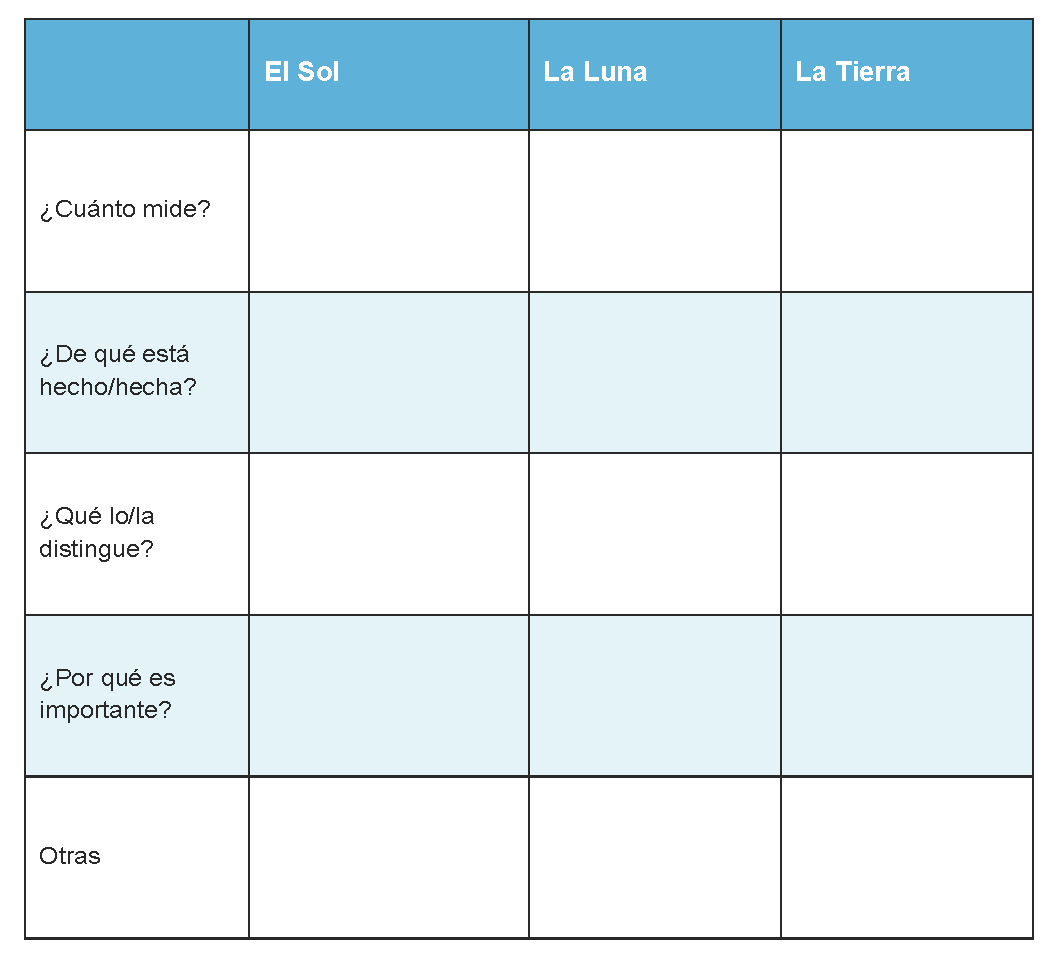Información para los maestros
Conexiones con el currículo
Esta investigación está relacionada con los siguientes Estándares de Ciencias del Grado 5 para las Próximas Generaciones.
PS1.A: Estructura y propiedades de la materia
Matter of any type can be subdivided into particles that are too small to see, but even then the matter still exists and can be detected by other means. A model showing that gases are made from matter particles that are too small to see and are moving freely around in space can explain many observations, including the inflation and shape of a balloon and the effects of air on larger particles or objects. (5-PS1-1)
The amount (weight) of matter is conserved when it changes form, even in transitions in which it seems to vanish. (5-PS1-2)
Measurements of a variety of properties can be used to identify materials. (Boundary: At this grade level, mass and weight are not distinguished, and no attempt is made to define the unseen particles or explain the atomic-scale mechanism of evaporation and condensation.) (5-PS1-3)
PS2.B: Tipos de interacción
The gravitational force of Earth acting on an object near Earth’s surface pulls that object toward the planet’s center. (5-PS2-1)
PS3.D: La energía en los procesos químicos y la vida cotidiana
The energy released [from] food was once energy from the sun that was captured by plants in the chemical process that forms plant matter (from air and water). (5-PS3-1)
ESS1.A: El universo y sus estrellas
The sun is a star that appears larger and brighter than other stars because it is closer. Stars range greatly in their distance from Earth. (5-ESS1-1)
ESS1.B: La Tierra y el sistema solar
The orbits of Earth around the sun and of the moon around Earth, together with the rotation of Earth about an axis between its North and South poles, cause observable patterns. These include day and night; daily changes in the length and direction of shadows; and different positions of the sun, moon, and stars at different times of the day, month, and year. (5-ESS1-2)
ESS2.A: Materiales y sistemas de la Tierra
Earth’s major systems are the geosphere (solid and molten rock, soil, and sediments), the hydrosphere (water and ice), the atmosphere (air), and the biosphere (living things, including humans). These systems interact in multiple ways to affect Earth’s surface materials and processes. The ocean supports a variety of ecosystems and organisms, shapes landforms, and influences climate. Winds and clouds in the atmosphere interact with the landforms to determine patterns of weather. (5-ESS2-1)
ESS3.C: Impacto de los seres humanos en los sistemas de la Tierra
Human activities in agriculture, industry, and everyday life have had major effects on the land, vegetation, streams, ocean, air, and even outer space. But individuals and communities are doing things to help protect Earth’s resources and environments. (5-ESS3-1)
Sitios web útiles
Si lo desea, puede dirigir a sus estudiantes a todos estos sitios web o a algunos de ellos como ayuda para sus investigaciones.
https://www.nasa.gov/audience/forstudents/index.html (disponible en inglés)
https://www.nasa.gov/kidsclub/index.html (disponible en inglés)
El sitio web Kids Astronomy tiene mucha información excelente:
https://kidsastronomy.com (disponible en inglés). Buscar: our solar system.
Los estudiantes pueden ver cómo observan el espacio los científicos en este video sobre telescopios increíbles:
https://ssec.si.edu/explore-smithsonian-how-do-astronomers-see-invisible-parts-universe (disponible en inglés)
Los estudiantes pueden hacer un recorrido por el universo con el Centro de Astrofísica Harvard-Smithsonian:
https://www.cfa.harvard.edu/seuforum/opis_tour_earth.htm (disponible en inglés).
Cómo hacer búsquedas en Internet
1 Busca con pocas palabras
Cuantas menos palabras uses, más precisa será la búsqueda.
2 Elige exactamente lo que quieres buscar
Por ejemplo: clima del círculo polar ártico
3 Usa comillas
Si pones una serie de palabras entre comillas dobles, le dices al motor de búsqueda que busque exactamente esas palabras en ese mismo orden, sin hacer ningún cambio. Por ejemplo: “clima del círculo polar ártico”
4 Usa el signo más (+)
Si agregas un signo más (+) entre las palabras, se buscan todas las palabras. Por ejemplo: migrar+aves+ballenas+mamífero
5 Usa el signo menos (–) para decir lo que no quieres buscar
Usa el signo menos (–) para indicar palabras que no quieres que aparezcan en los resultados de tu búsqueda. Por ejemplo: si buscas animales de madriguera y no quieres que aparezcan mamíferos en tu búsqueda, escribe –mamíferos para excluir a los mamíferos. Tienes que insertar un espacio antes del signo menos para que no se busque la palabra.
6 Ten muy claro lo que no quieres buscar
Parte 1
Haz preguntas y define problemas
Es posible que después de leer La Tierra, el Sol y la Luna tengas preguntas sobre estas partes del sistema solar.
Escribe tus preguntas.
- Compara tu lista con las preguntas de los demás.
- Elige una pregunta que te gustaría investigar.
- Puedes trabajar solo, con un compañero o en un grupo pequeño.
Puedes elegir una o más de estas preguntas para investigar:
P1. ¿Qué información se está recopilando sobre la Luna? ¿Cómo se la recopila?
P2. ¿Qué información se está recopilando sobre el Sol? ¿Cómo se la recopila?
P3. ¿Cómo estudian los científicos a la Tierra, el Sol y la Luna? ¿Por qué es importante?
Ir a la Parte 2 Investiga →Parte 2
Investiga
Busca información en Internet o en libros, o habla con personas que puedan ayudarte a hallar lo que buscas.
Tu maestro puede sugerirte sitios web adecuados donde buscar más información.
Ir a la Parte 3 Anota los datos →Parte 3
Anota los datos
Busca una forma de anotar la información que te permita ver patrones en los datos.
Esta tabla puede ayudarte a organizar los datos cuando investigues.
Pregunta principal: ______________________________
 Descargar la tabla
Descargar la tabla
Ir a la Parte 4 Organiza, analiza e interpreta los datos →
Parte 4
Organiza, analiza e interpreta los datos
1. Mira la información que reuniste y los patrones que hallaste.
¿Qué has aprendido sobre la Tierra, el Sol y la Luna?
¿Qué has aprendido sobre las relaciones entre los movimientos de la Tierra, el Sol y la Luna?
¿Por qué estos movimientos son importantes?
¿Qué sabes sobre la relación entre la Tierra, el Sol y la Luna?
2. Busca otros patrones.
3. Toma notas sobre lo que halles.
Ir a la Parte 5 Presenta y comparte →Parte 5
Presenta y comparte
Mira toda la información que reuniste durante tu investigación y tus razonamientos.
¿Cuáles son las ideas más importantes sobre la Tierra, la Luna y el Sol?
Escribe las ideas más importantes en una tabla.
 Descargar la tabla
Descargar la tabla
← Volver al menú
